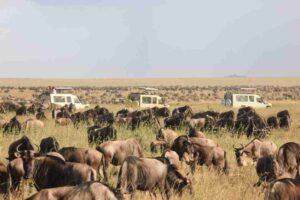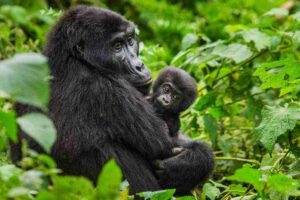| Name of the facility | Soroi Larsens Camp |
|---|---|
| Certification Achieved | Silver |
| Year opened | 2003 |
| Tourism region | Laikipia/Samburu |
| County | Samburu |
| Address | Samburu National Reserve Map It |
| Telephone/Mobile | : +254 720626367 |
| [email protected] | |
| Website | https://larsenscamp.com/ |
| Facility Notes | Larsens Camp is located within Samburu National Reserve. It occupies 20 acres of land on a lease period of 20 years from Samburu County Government. The facility has 20 luxury tents with a maximum bed capacity of 40 and a total of 26 permanent staff. Wilderness Lodges Limited currently owns and manages the facility. Samburu National Reserve is located along the banks of the Ewaso Ng’iro River bordering north of Buffalo Springs National Reserve in Northern Kenya. The Reserve is 165 km² in size and approximately 350 kilometres from Nairobi. Samburu, Buffalo Springs and Shaba National Reserves are the only wildlife-protected areas, comprising less than 5% of the Samburu-Laikipia ecosystem. The Reserves provide refuge to near-threatened animals’ species i.e. Grevy’s zebra, Beisa Oryx and Greater Kudu, and over 350 species of birds. The Reserve has a high abundance of many large carnivores, including the rare wild dog, antelopes and reptiles. |
| Energy management | Larsen’s camp is mainly powered by 3 generators which are used for lighting and running the refrigerants. These are supplemented by LPG gas which is used for guests and staff cooking. Conservation of energy in the camp is conducted through: power rationing for at least eight hours daily, keeping daily records of generator fuel consumption, use of energy saving bulbs and Light emitting diodes and sensitisation of guests and staff on energy conservation measures such as switching off unnecessary lights |
| Environmental management | Larsens Camp has a clear environmental policy committed to sustainability and environmental protection with emphasis on compliance with the law, responsible resource use and engagement in corporate social responsibility. |
| Chemical use | Only biodegradable bathroom amenities from clique limited are used within the facility while Henkel Chemicals are used in maintenance of the swimming pool. The gas used in both the staff and guest kitchen is properly caged with precautionary signage well mounted. The camp stores its diesel in a reservoir of 5,000 litres. |
| Conservation Criteria | |
| Community Criteria | |
| Solid waste management | Waste separation is done at source in clearly labelled bins whereby plastic, metallic and glass waste is collected and transported for further management to the camp’s sister hotel, Samburu Game Lodge. The used oil is collected in a well bunded underground reservoir and later stored in20 litre containers before disposal through Samburu County. However, most of the oil is donated to the locals. |
| Water management | Main source of water for the camp is obtained from a borehole within the camp. The water is pumped, treated and stored in 132,000 litres reservoirs before being distributed via gravity to the entire premises. The water is metered at the main inlet for monitoring purposes. Low shower filter heads are installed in the guest tent showers for efficient water use. In addition, guests are sensitized on water conservation efforts through ‘towel talks’ and room information folders. The staff members are also sensitised to conserve water. |
| Visitor communication & education | Guests are briefed upon arrival on the environmental principles and values of the camp and are provided with more information about Samburu National Reserve, Wildlife conservation and the Samburu community through Booklets, room information folders and magazines available at the guest tents. |
| Pollution | Low light emitting path lights are used to reduce on light pollution while the generator is set in a sound proof room to reduce on noise pollution. |
| Environmental conservation | The camp is built on low impact, with beige canvas tents that blend in with the natural surroundings and pathways left natural with grass trimmed to demarcate way while natural vegetation is undisturbed. The camp being within the reserve contributes bed night fees to Samburu County government. In addition, the camp supports the Ewaso Lions Project and Save the Elephants through guides’ volunteers to assist in monitoring lions and elephants within the reserve. The management also sensitizes guests on lion conservation and invites researchers to give lectures on elephant and lion monitoring progress and initiatives. Further, guests are encouraged to engage in low impact activities such as village visits, nature treks, game drives and bird watching. |
| Waste water management | Grey water from the guest rooms and staff quarters is managed through septic tanks while that from the kitchen goes through grease traps first to filter out the fats and oils before draining into a septic tank. Black water from the guest tents, public areas and staff quarters is also managed through septic tanks fixed with access manholes. They are regularly exhausted by the county government. The camps swimming pool is cleaned by sieving and vacuum cleaning with daily conduction of backwash. Records for the swimming pool are available. |
| Purchasing and supplies | Fruits and vegetables are packed in reusable crates while meat and dairy products are stored in freezers. The camp buys its dry goods in bulk to reduce on packaging material and then packs it in reusable containers. |
| Employment and remuneration/staff welfare | Employees’ issues are addressed by a staff welfare committee. |
| Staff education, communication and awareness training | The facility holds daily departmental staff briefings for planning activities and contains notice boards which are used as a communication means to staff members. |
| Cultural preservation and promotion/protection of local sites | The facility offers village visits to guests for cultural experiences at Lorubae and Umoja villages and encourages guests to buy beadwork products directly from the local women. The camp organises cultural dances from the local community for guests, on demand. |
| Benefits to local community/community empowerment | Approximately 80% of the camp’s staff is from the local Samburu community. Staff benefits include food, uniform, healthcare and accommodation facilities. In addition the camp enhances the economic standards of the local community by purchasing locally where possible and organising village visits for the guests to buy cultural artefacts and curios directly from the local community. The locals also benefit from Larsens camp through transportation to the lodge clinic or the nearest health facility at Archer’s post in case of medical emergencies. |
| Cultural Criteria | |
| Health and safety | Larsens Camp has a health and safety committee which manages the health and safety issues within the camp and meets monthly to conduct internal audits. Medical emergencies for both staff and guests are referred to a clinician in Samburu Game lodge, 6 KM away. First aid kits are available at the main office and vehicles and the clinician conducts in-house first aid training for the staff. There is also an emergency fire evacuation plan in place with clearly spelt out procedures on health care and security emergency contacts placed in all guest tents. The guest tents are equipped with whistles and torches for emergency response and precautionary and safety signage is fixed at the main fuel storage areas and generator room to enhance safety Fire-fighting equipment including fire extinguishers and fire blankets at the kitchen are duly serviced and strategically placed within the facility. The camp provides PPE (Personal Protective Equipment) such as overall, gloves and boots to the staff and holds demonstrations on fire-fighting skills at least twice a year. Fire assembly points are properly marked and displayed within the camp and a fire alarm fixed for fire emergency response |
| Child labor, abuse and human rights | The facility does not employ any person below the legal working age. |
| Business Practises Criteria | |
| Entry Date | 12th March 2018 |













